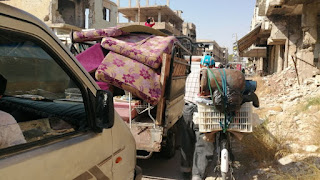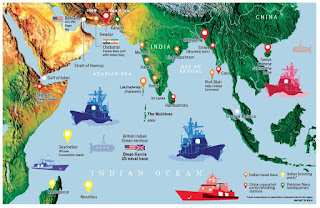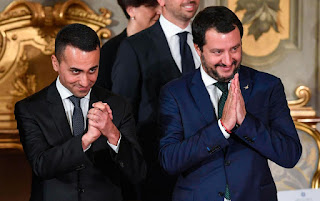Syrian Forces March into Daraa
Photo source: The New Arab
By Naveed Qazi | Editor, Globe Upfront
In July 2021, Assad’s forces marched into Daraa, the birthplace of Syria’s eleven-year-old revolution. Its townspeople were responsible for the then-unimaginable scenes of bravery against the central government, including knocking down the statue of former President Hafez Assad in March 2011.
Daraa has endured government shellings, air strikes and worse in the years that followed. It’s conquer has given Russia a reason to advance its imperial ambitions. The ceasefire deal was showcased for those interests. Russia’s thought of a grand colonial vision of 'reconstruction', really means that Russia is becoming the imperialist suzerain over remaining Syria. Infact, Daraa was a place which the pro-regime forces had conquered first in 2018.
In Russia's vision for Syria, the financial and geopolitical exploitation for decades to come provides it with all kind of money-spinning ventures. The ever-viable colonial adventure will bring in investment from its allies, and the ever-more Assad friendly Gulf states and Arab League. According to an Oped by Sam Hamad in The New Arab: ‘This in turn could prompt ideological allies among EU and western world to get in on the scramble for Syria somewhere along the way.’
The deal was drafted in ways such that the regime would take over the running of social provisions, and the rebels would hand over heavy weaponry and be incorporated into the Russian-created 'Fifth Corps' of the Syrian Arab Army, which would work with Russia to police the area, denying Assad and Iran any military access. But since the deal was struck, Assad has tried to rip it apart.
With economic failures in Assad's kleptocratic rump state, Daraa has become a natural hotbed of resistance. When this autonomous province decided to boycott the 2021 Syrian presidential election, Assad decided on a brutal siege in Daraa. The siege then turned into an all-out offensive, with Assad shelling civilian areas, leading to deaths of many, including women and children. Eighty percent of the population was evacuated, while Daraa was left besieged and its people faced starvation. The people there had either managed to smuggle wheat or subsisted on stored inventories. Medicines and water are also hard to come by.
In July 2021, it was decided that the residents of Daraa would surrender a number of light weaponries, and allow the regime to install three security checkpoints, within the city, in exchange for the regime lifting of the siege.
However, the deal with Daraa negotiating committee fell apart after the regime claimed the weapons turned over were unsatisfactory, and raised the number of security checkpoints it wanted to install in the city from three to ten. Regime soldiers and allied militias attempted to storm the city a few days later. Since then, negotiations have not budged, despite the Russians bringing both parties to the table several times.
The UN has called for an immediate ceasefire to "alleviate the suffering of civilians in Daraa" and for "unimpeded access for humanitarian relief".
There is a stern resistance against regime forces in Daraa, and it seems that they can’t fight effectively without Russian airpower support. Though Russian intervention assured Assad's military success, in reality, Russia finds itself increasingly overstretched in Syria. It has not carved stability out of Assad's parochial ultra-corrupt rump state, and Iran's often quite divergent interests.
Iran rules the ground, and has the most control over Assad, given many of its Revolutionary Guard forces and proxy militias give the regime much needed manpower. During this conflict in Daraa, Iran is actively undermining Russian 'peace' negotiations with the central committees, indicating it wants to prompt a total conquest of the region. It could be that Russia might concede in order for peace to prevail. At the same time, Assad regime isn't suddenly going to become a force for peace, and the people of Daraa are not going to willingly surrender their liberty, amid the superficial condemnation from United States and international community at large. Although, the Arabs who supported the rebels of Daraa are keen to embrace Assad.
Neighbouring Sweida, predominantly inhabited by the Druze community, who refused a conscription in the Syrian army, run their own militia, and have broadly refused to join their neighbours in Daraa, in the active military uprising against Damascus.
Generally speaking, when it comes to UAE and the Kingdom of Saudi Arabia, it doesn't want strong Iranian influences in Syria, and instead see Assad as the only one who can balance Iranian influence in the region. Moreover, they also see Assad as useful in countering Turkish footprint in Arab lands. United States, on the other hand, wants a resolution according to United Nations Security Council resolution 2254, which is also making things easy for Assad.
Daraa has endured government shellings, air strikes and worse in the years that followed. It’s conquer has given Russia a reason to advance its imperial ambitions. The ceasefire deal was showcased for those interests. Russia’s thought of a grand colonial vision of 'reconstruction', really means that Russia is becoming the imperialist suzerain over remaining Syria. Infact, Daraa was a place which the pro-regime forces had conquered first in 2018.
In Russia's vision for Syria, the financial and geopolitical exploitation for decades to come provides it with all kind of money-spinning ventures. The ever-viable colonial adventure will bring in investment from its allies, and the ever-more Assad friendly Gulf states and Arab League. According to an Oped by Sam Hamad in The New Arab: ‘This in turn could prompt ideological allies among EU and western world to get in on the scramble for Syria somewhere along the way.’
The Daraa deal was supposed to announce that Russia was now the main guarantor of stability in the region, whilst a retreating United States. This deal differs from the deals of the past, where the genocidal fates of Aleppo and Homs weren’t let loose in Daraa. Assad and Iran have grudgingly supported it.
Under the 2018 deal, the Daraa was to be split in two: the eastern side, fully occupied by the Assad regime, and the western side, including Daraa City, which was to be put under semi-autonomous control of rebel forces and civilian revolutionary forces, forming elected Central Committees representing different areas of the semi-autonomous zone.
Under the 2018 deal, the Daraa was to be split in two: the eastern side, fully occupied by the Assad regime, and the western side, including Daraa City, which was to be put under semi-autonomous control of rebel forces and civilian revolutionary forces, forming elected Central Committees representing different areas of the semi-autonomous zone.
The deal was drafted in ways such that the regime would take over the running of social provisions, and the rebels would hand over heavy weaponry and be incorporated into the Russian-created 'Fifth Corps' of the Syrian Arab Army, which would work with Russia to police the area, denying Assad and Iran any military access. But since the deal was struck, Assad has tried to rip it apart.
With economic failures in Assad's kleptocratic rump state, Daraa has become a natural hotbed of resistance. When this autonomous province decided to boycott the 2021 Syrian presidential election, Assad decided on a brutal siege in Daraa. The siege then turned into an all-out offensive, with Assad shelling civilian areas, leading to deaths of many, including women and children. Eighty percent of the population was evacuated, while Daraa was left besieged and its people faced starvation. The people there had either managed to smuggle wheat or subsisted on stored inventories. Medicines and water are also hard to come by.
In July 2021, it was decided that the residents of Daraa would surrender a number of light weaponries, and allow the regime to install three security checkpoints, within the city, in exchange for the regime lifting of the siege.
However, the deal with Daraa negotiating committee fell apart after the regime claimed the weapons turned over were unsatisfactory, and raised the number of security checkpoints it wanted to install in the city from three to ten. Regime soldiers and allied militias attempted to storm the city a few days later. Since then, negotiations have not budged, despite the Russians bringing both parties to the table several times.
The UN has called for an immediate ceasefire to "alleviate the suffering of civilians in Daraa" and for "unimpeded access for humanitarian relief".
There is a stern resistance against regime forces in Daraa, and it seems that they can’t fight effectively without Russian airpower support. Though Russian intervention assured Assad's military success, in reality, Russia finds itself increasingly overstretched in Syria. It has not carved stability out of Assad's parochial ultra-corrupt rump state, and Iran's often quite divergent interests.
Iran rules the ground, and has the most control over Assad, given many of its Revolutionary Guard forces and proxy militias give the regime much needed manpower. During this conflict in Daraa, Iran is actively undermining Russian 'peace' negotiations with the central committees, indicating it wants to prompt a total conquest of the region. It could be that Russia might concede in order for peace to prevail. At the same time, Assad regime isn't suddenly going to become a force for peace, and the people of Daraa are not going to willingly surrender their liberty, amid the superficial condemnation from United States and international community at large. Although, the Arabs who supported the rebels of Daraa are keen to embrace Assad.
Neighbouring Sweida, predominantly inhabited by the Druze community, who refused a conscription in the Syrian army, run their own militia, and have broadly refused to join their neighbours in Daraa, in the active military uprising against Damascus.
Generally speaking, when it comes to UAE and the Kingdom of Saudi Arabia, it doesn't want strong Iranian influences in Syria, and instead see Assad as the only one who can balance Iranian influence in the region. Moreover, they also see Assad as useful in countering Turkish footprint in Arab lands. United States, on the other hand, wants a resolution according to United Nations Security Council resolution 2254, which is also making things easy for Assad.




Comments
Post a Comment
Advice from the Editor: Please refrain from slander, defamation or any kind of libel in the comments section.